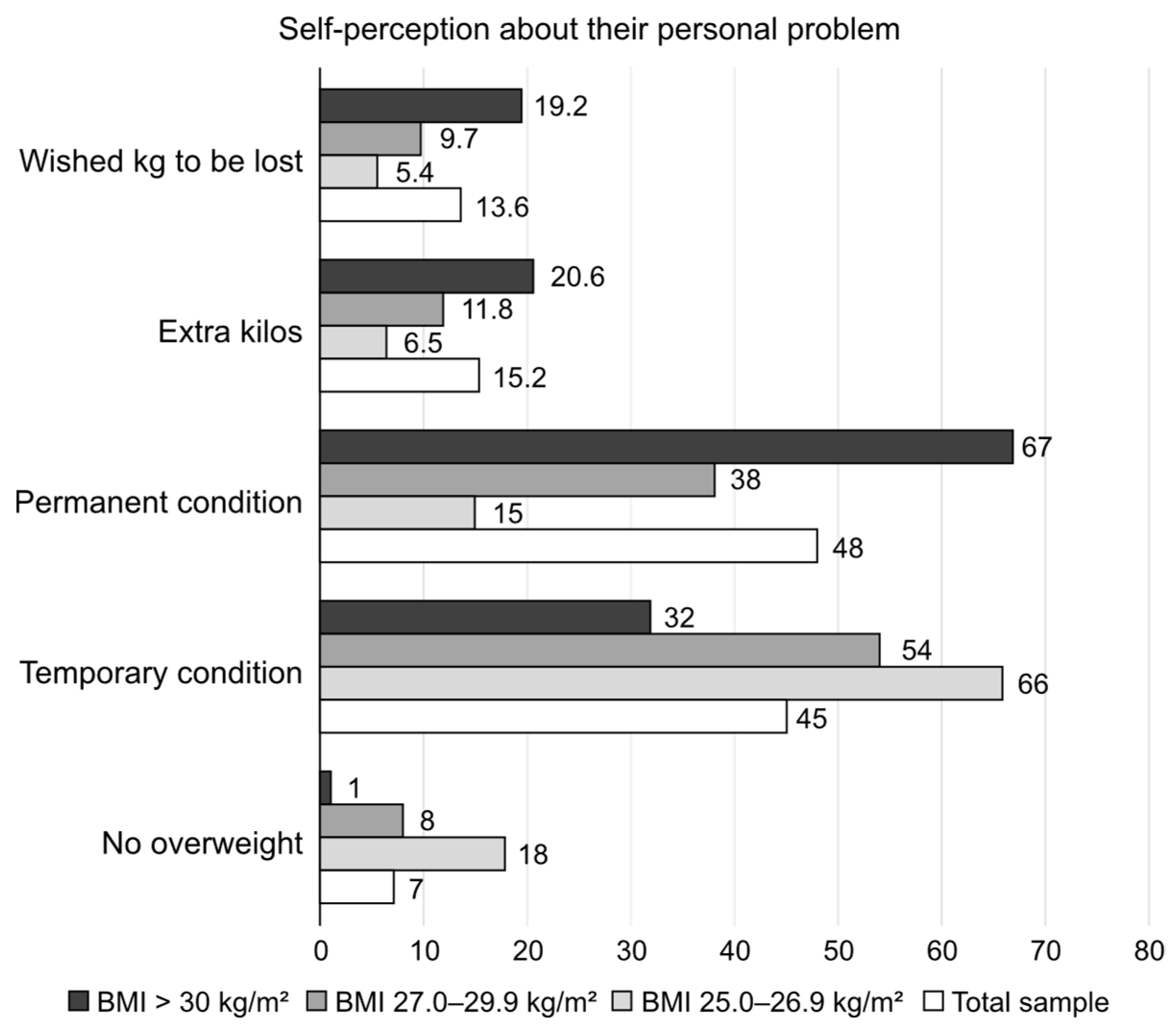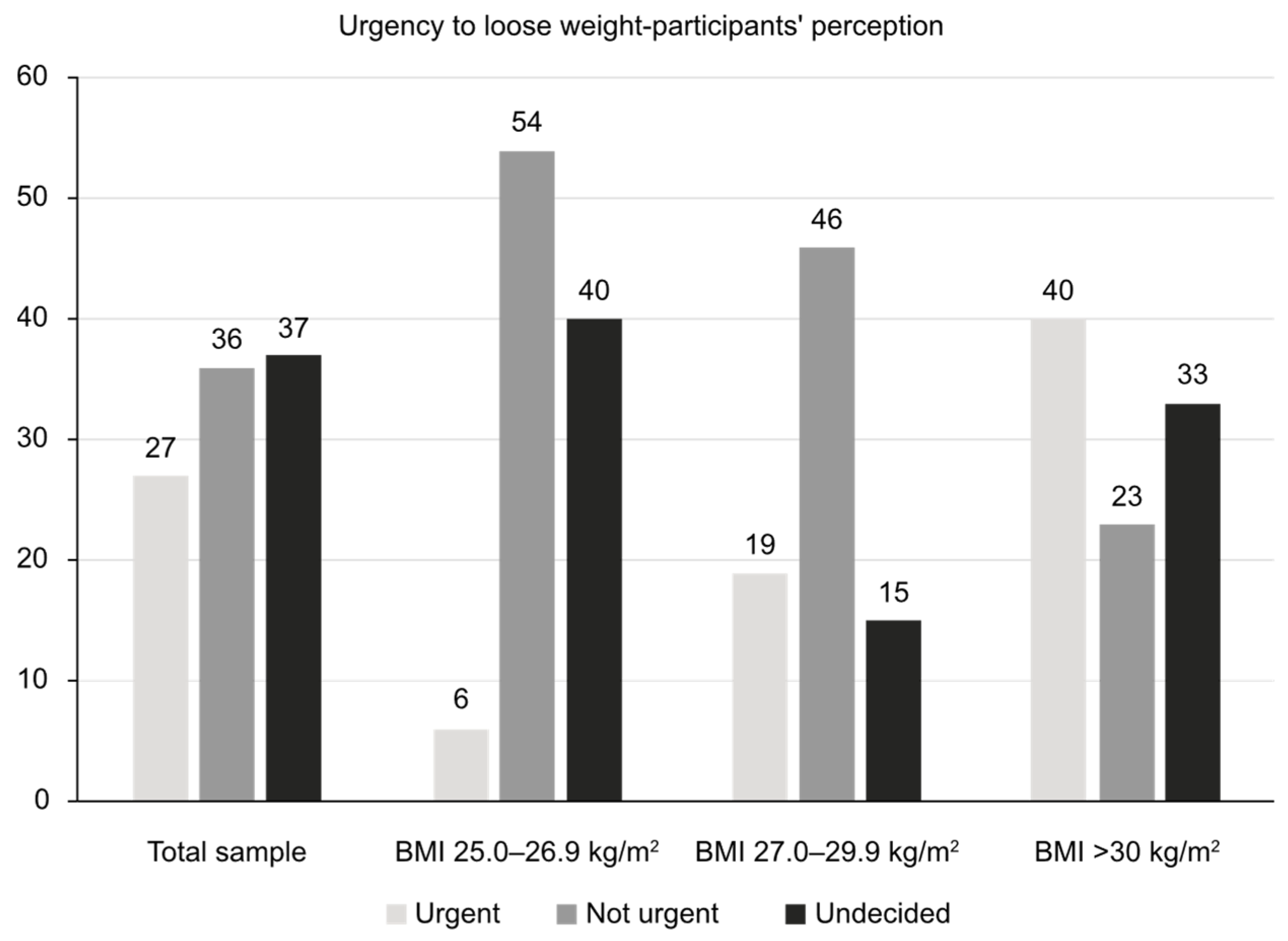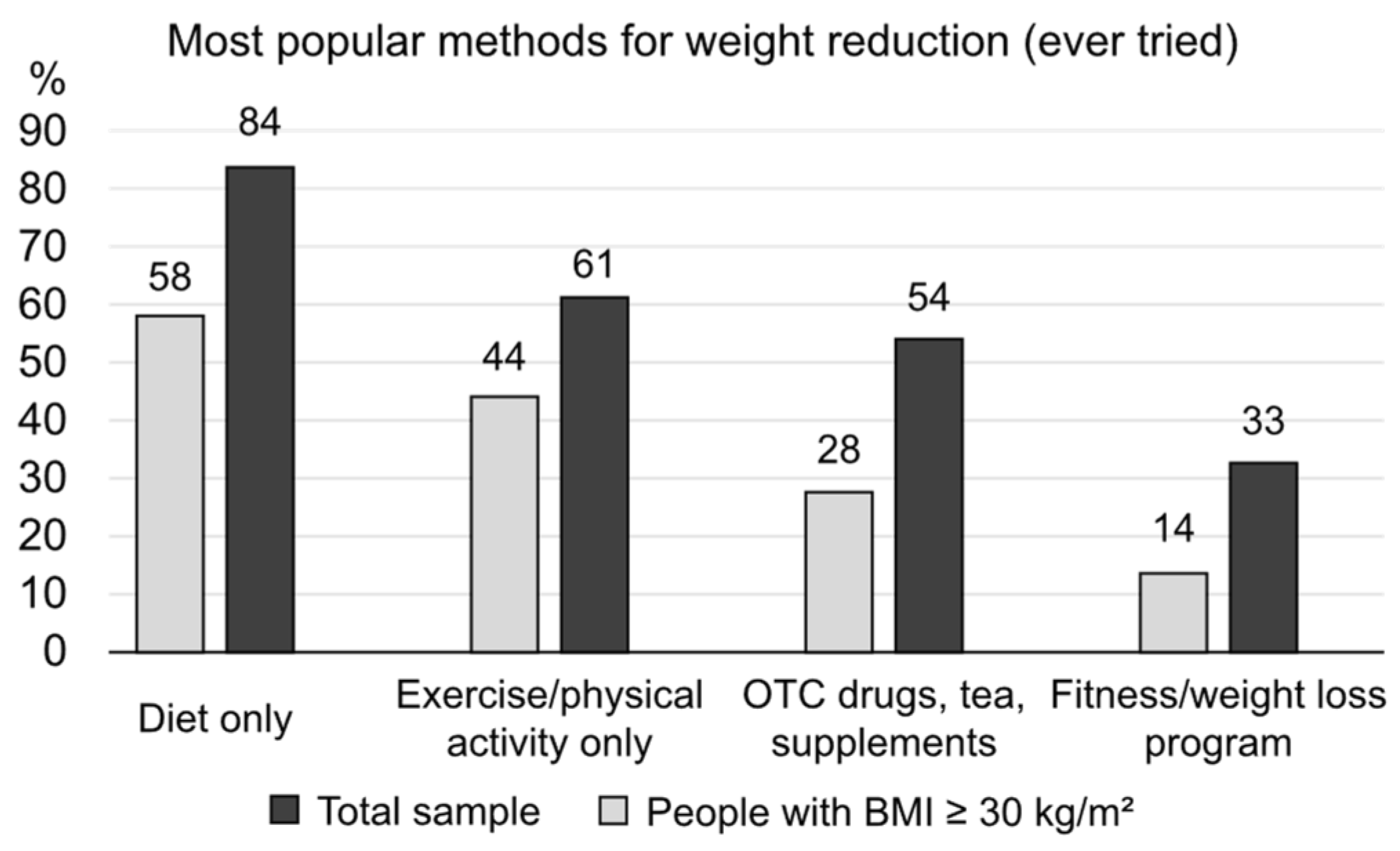The Perceptions of and Attitudes Toward Obesity in Bulgarian Adults with a BMI ≥ 25.0 kg/m2—An Exploratory Study
Highlights
- A substantial proportion of people living with obesity do not perceive being overweight as a health problem.
- Very few people living with obesity are well-aware of obesity-associated diseases and health hazards.
- General practitioners and other medical personnel do not sufficiently address the problem of obesity/overweight.
- Diet and physical activity are regarded as the main available options; however, these are perceived as having no long-lasting results. Less than half of the participants would try weight-loss drugs.
- A substantial amount of education about obesity-associated diseases and their proper management for both the general population and the medical community is needed.
Abstract
1. Introduction
2. Materials and Methods
2.1. Study Design and Ethical Standards
2.2. Participants
- Aged between 25 and 59 years;
- BMI ≥ 25.0 kg/m2;
- Household monthly income above the Bulgarian average (BGN ≥ 2400 ≈ EUR ≥ 1200 for the pilot group and BGN ≥ 3000 ≈ EUR ≥ 1500 for the actual survey participants). The respondents were divided into 2 cohorts based on their age: 25–39 y/o and 40–59 y/o. The participants’ body mass index was calculated based on self-reported height and weight during recruitment and following the interview. The income criteria were introduced to select participants able to afford more expensive diets, food supplements, or drugs typically utilized in the management of obesity.
2.3. Questionnaire
2.4. Statistical Analysis
3. Results
3.1. Demographic Profile of the Respondents
3.2. Overall Health and Concomitant Diseases—Participant Evaluation
3.3. Self-Perception of Being Overweight/Obese and the Urgency to Lose Weight
3.4. Perceived Reasons for Being Overweight/Obese
3.5. Preferred Information Sources About Being Overweight/Obese
3.6. Management of Overweight/Obesity—Knowledge and Attitudes
4. Discussion
Strengths and Limitations
5. Conclusions
Supplementary Materials
Author Contributions
Funding
Institutional Review Board Statement
Informed Consent Statement
Data Availability Statement
Acknowledgments
Conflicts of Interest
References
- Purnell, J.Q. Definitions, Classification, and Epidemiology of Obesity. In Endotext [Internet]; Feingold, K.R., Anawalt, B., Blackman, M.R., Boyce, A., Chrousos, G., Corpas, E., de Herder, W.W., Dhatariya, K., Dungan, K., Hofland, J., et al., Eds.; Updated 4 May 2023; MDText.com, Inc.: South Dartmouth, MA, USA, 2000. Available online: https://www.ncbi.nlm.nih.gov/books/NBK279167/ (accessed on 9 January 2025).
- Bays, H.E.; Kirkpatrick, C.; Maki, K.C.; Toth, P.P.; Morgan, R.T.; Tondt, J.; Christensen, S.M.; Dixon, D.; Jacobson, T.A. Obesity, dyslipidemia, and cardiovascular disease: A joint expert review from the Obesity Medicine Association and the National Lipid Association 2024. Obes. Pillars 2024, 10, 100108. [Google Scholar] [CrossRef]
- Eymard, F.; Aron-Wisnewsky, J. Osteoarthritis in patients with obesity: The bariatric surgery impacts on its evolution. Jt. Bone Spine 2024, 91, 105639. [Google Scholar] [CrossRef] [PubMed]
- Bjork, S.; Jain, D.; Marliere, M.H.; Predescu, S.A.; Mokhlesi, B. Obstructive Sleep Apnea, Obesity Hypoventilation Syndrome, and Pulmonary Hypertension: A State-of-the-Art Review. Sleep Med. Clin. 2024, 19, 307–325. [Google Scholar] [CrossRef] [PubMed]
- Ali, M.M.; Parveen, S.; Williams, V.; Dons, R.; Uwaifo, G.I. Cardiometabolic comorbidities and complications of obesity and chronic kidney disease (CKD). J. Clin. Transl. Endocrinol. 2024, 36, 100341. [Google Scholar] [CrossRef] [PubMed]
- Khawaja, T.; Nied, M.; Wilgor, A.; Neeland, I.J. Impact of Visceral and Hepatic Fat on Cardiometabolic Health. Curr. Cardiol. Rep. 2024, 26, 1297–1307. [Google Scholar] [CrossRef] [PubMed]
- Hernando-Requejo, O.; García de Quinto, H. La obesidad y su relación con el cáncer [Obesity and its relationship with cancer]. Nutr. Hosp. 2024, 41, 52–56. [Google Scholar] [PubMed]
- Nagi, M.A.; Ahmed, H.; Rezq, M.A.A.; Sangroongruangsri, S.; Chaikledkaew, U.; Almalki, Z.; Thavorncharoensap, M. Economic costs of obesity: A systematic review. Int. J. Obes. 2024, 48, 33–43. [Google Scholar] [CrossRef] [PubMed]
- Kotsopoulos, N.; Connolly, M.P. Assessing the Fiscal Burden of Obesity in Canada by Applying a Public Economic Framework. Adv. Ther. 2024, 41, 379–390. [Google Scholar] [CrossRef]
- Toliver, J.; Schnecke, V.; Rizkallah, L. The Clinical and Economic Burdens of Obesity and the Value of Weight Loss for an EMR-Derived US Cohort: A Modeling Study. Popul. Health Manag. 2024, 27, 300–306. [Google Scholar] [CrossRef] [PubMed]
- Agarwal, M.; Nadolsky, K. Attitudes, Perceptions, and Practices Among Endocrinologists Managing Obesity. Endocr. Pract. 2022, 28, 179–184. [Google Scholar] [CrossRef] [PubMed]
- Wangler, J.; Jansky, M. Attitudes, behaviours and strategies towards obesity patients in primary care: A qualitative interview study with general practitioners in Germany. Eur. J. Gen. Pract. 2021, 27, 27–34. [Google Scholar] [PubMed]
- Ananthakumar, T.; Jones, N.R.; Hinton, L.; Aveyard, P. Clinical encounters about obesity: Systematic review of patients’ perspectives. Clin. Obes. 2020, 10, e12347. [Google Scholar] [PubMed]
- Balani, R.; Herrington, H.; Bryant, E.; Lucas, C.; Kim, S.C. Nutrition knowledge, attitudes, and self-regulation as predictors of overweight and obesity. J. Am. Assoc. Nurse Pract. 2019, 31, 502–510. [Google Scholar] [CrossRef] [PubMed]
- Joslyn, M.R.; Haider-Markel, D.P. Perceived causes of obesity, emotions, and attitudes about Discrimination Policy. Soc. Sci. Med. 2019, 223, 97–103. [Google Scholar] [PubMed]
- Atwood, M.E. Emotion dysregulation and obesity: A conceptual review of the literature. Clin. Obes. 2024, 14, e12699. [Google Scholar] [PubMed]
- Amaya-Hernández, A.; Ortega-Luyando, M.; Mancilla-Diaz, J.M.; Alvarez-Rayón, G.; Cruz-Navarro, M.; Pérez-Ortiz, A. Differences in body dissatisfaction between individuals with and without stigma toward obesity: A study of preadolescents and adolescents. Eat. Weight Disord. 2024, 29, 66. [Google Scholar] [PubMed]
- Borissova, A.-M.; Shinkov, A.D.; Vlahov, J.D.; Dakovska, L.N.; Todorov, T.C. Survey on the Prevalence of Obesity in Bulgarian population in 2012 year. J. Endocrinol. 2015, 20, 82–92. [Google Scholar]
- Borissova, A.-M.; Shinkov, A.D.; Vlahov, J.D.; Dakovska, L.N.; Todorov, T.C. Metabolic Syndrome in Bulgarian Population in 2012 Year. J. Endocrinol. 2015, 20, 144–152. [Google Scholar]
- Salvador, J.; Vilarrasa, N.; Poyato, F.; Rubio, M.Á. Perceptions, Attitudes, and Barriers to Obesity Management in Spain: Results from the Spanish Cohort of the International ACTION-IO Observation Study. J. Clin. Med. 2020, 9, 2834. [Google Scholar] [CrossRef] [PubMed]
- Kaplan, L.M.; Golden, A.; Jinnett, K.; Kolotkin, R.L.; Kyle, T.K.; Look, M.; Nadglowski, J.; O’Neil, P.M.; Parry, T.; Tomaszewski, K.J.; et al. Perceptions of Barriers to Effective Obesity Care: Results from the National ACTION Study. Obesity 2018, 26, 61–69. [Google Scholar]
- Colangeli, L.; Russo, B.; Capristo, E.; Mariani, S.; Tuccinardi, D.; Manco, M.; Scipione, V.; Parrotta, M.E.; Capoccia, D.; Guglielmi, V. Attitudes, weight stigma and misperceptions of weight loss strategies among patients living with obesity in the Lazio Region, Italy. Front. Endocrinol. 2024, 15, 1434360. [Google Scholar] [CrossRef] [PubMed]
- Barakat, O.; Babili, M.; AlFaraj, N.; Almusalam, R.; Swartz, S.; Al-Hussain, B.N.; Flood, J.; Ali, K.F. Bodyweight and obesity perceptions among adults in Bahrain. East. Mediterr. Health J. 2024, 30, 196–203. [Google Scholar] [CrossRef] [PubMed]
- Ji, L.; Mu, Y.; Chang, C.; Wang, H.; Zhao, D.; Liu, D.; Shen, Z.; Chen, W. Perceptions, attitudes and barriers to effective obesity care among people living with obesity and healthcare professionals in China: The ACTION-China study. Diabetes Obes. Metab. 2024, 26, 4694–4704. [Google Scholar] [CrossRef] [PubMed]
- Zelenytė, V.; Valius, L.; Domeikienė, A.; Gudaitytė, R.; Endzinas, Ž.; Šumskas, L.; Maleckas, A. Body size perception, knowledge about obesity and factors associated with lifestyle change among patients, health care professionals and public health experts. BMC Fam. Pract. 2021, 22, 37. [Google Scholar] [CrossRef]
- Gudzune, K.A.; Kaplan, L.M.; Kahan, S.; Kumar, R.B.; Dunn, J.P.; Ahmad, N.N.; Poon, J.L.; Sims, T.J.; Mackie, D.S.; Jauregui, A.K.; et al. OBSERVE study. Weight-Reduction Preferences Among OBSERVE Study Participants With Obesity or Overweight: Opportunities for Shared Decision-Making. Endocr. Pract. 2024, 30, 917–926. [Google Scholar] [CrossRef] [PubMed]
- Caterson, I.D.; Alfadda, A.A.; Auerbach, P.; Coutinho, W.; Cuevas, A.; Dicker, D.; Hughes, C.; Iwabu, M.; Kang, J.H.; Nawar, R.; et al. Gaps to bridge: Misalignment between perception, reality and actions in obesity. Diabetes Obes. Metab. 2019, 21, 1914–1924. [Google Scholar] [CrossRef] [PubMed]
- Salle, L.; Foulatier, O.; Coupaye, M.; Frering, V.; Constantin, A.; Joly, A.S.; Braithwaite, B.; Gharbi, F.; Jubin, L. ACTION-FRANCE: Insights into Perceptions, Attitudes, and Barriers to Obesity Management in France. J. Clin. Med. 2024, 13, 3519. [Google Scholar] [CrossRef]
- Yanovski, S.Z.; Yanovski, J.A. Approach to Obesity Treatment in Primary Care: A Review. JAMA Intern. Med. 2024, 184, 818–829. [Google Scholar] [CrossRef] [PubMed]
- Babicki, M.; Kłoda, K.; Ledwoch, J.; Malchrzak, W.; Janiak, S.; Krzyżanowski, F.; Zieliński, T.; Grabska, P.; Gajowiak, D.; Pokorna-Kałwak, D.; et al. Prevalence of Obesity among Polish Primary Care Population Considered Healthy. Nutrients. 2024, 16, 2973. [Google Scholar] [CrossRef]
- Warr, W.; Aveyard, P.; Albury, C.; Nicholson, B.; Tudor, K.; Hobbs, R.; Roberts, N.; Ziebland, S. A systematic review and thematic synthesis of qualitative studies exploring GPs’ and nurses’ perspectives on discussing weight with patients with overweight and obesity in primary care. Obes. Rev. 2021, 22, e13151. [Google Scholar] [CrossRef] [PubMed]
- McGuire, B.; Mahfouz, H.; Lorenz, H.; Archer, E. Sport and Exercise Medicine: A misunderstood specialty among medical students and foundation doctors. Int. J. Med. Stud. 2024, in press. [Google Scholar]
- Almuwaqqat, Z.; Hui, Q.; Liu, C.; Zhou, J.J.; Voight, B.F.; Ho, Y.L.; Posner, D.C.; Vassy, J.L.; Gaziano, J.M.; Cho, K.; et al. Long-Term Body Mass Index Variability and Adverse Cardiovascular Outcomes. JAMA Netw. Open 2024, 7, e243062. [Google Scholar] [CrossRef] [PubMed]
- Daigle, K.M.; Gang, C.H.; Kopping, M.F.; Gadde, K.M. Relationship Between Perceptions of Obesity Causes and Weight Loss Expectations Among Adults. J. Nutr. Educ. Behav. 2019, 51, 86–90. [Google Scholar] [CrossRef] [PubMed]
- Segal, Y.; Gunturu, S. Psychological Issues Associated with Obesity. In StatPearls [Internet]; StatPearls Publishing: Treasure Island, FL, USA, 2024. [Google Scholar]




| Total Sample N = 704 | BMI 25.0–26.9 kg/m2 N = 147 | BMI 27.0–29.9 kg/m2 N = 197 | BMI ≥ 30.0 kg/m2 N = 360 | |
|---|---|---|---|---|
| Sex | ||||
| Male/Female | 44/56 | 35/65 | 46/54 | 47/53 |
| Age | ||||
| 25–34 y/o | 21 | 25 | 23 | 19 |
| 35–44 y/o | 29 | 33 | 26 | 28 |
| 45–54 y/o | 28 | 29 | 30 | 27 |
| 55–64 y/o | 22 | 13 | 21 | 26 |
| Education | ||||
| Higher | 50 | 49 | 51 | 51 |
| Secondary | 50 | 51 | 49 | 49 |
| Family status | ||||
| Single | 19 | 18 | 20 | 19 |
| Married | 58 | 55 | 58 | 59 |
| In a partnership | 18 | 27 | 22 | 22 |
| Have children | 43 | 45 | 45 | 44 |
| No children | 57 | 55 | 55 | 56 |
| Employment | ||||
| Self-employed | 12 | 9 | 10 | 13 |
| Employee | 85 | 90 | 83 | 84 |
| Other | 3 | 1 | 7 | 3 |
| BMI 25.0–26.9 kg/m2 | BMI 27.0–29.9 kg/m2 | BMI ≥ 30.0 kg/m2 |
|---|---|---|
|
|
|
| Total Sample N = 704 | BMI 25.0–26.9 kg/m2 N = 147 | BMI 27.0–29.9 kg/m2 N = 197 | BMI ≥ 30.0 kg/m2 N = 360 | |
|---|---|---|---|---|
| Nutritionist | 25 | 23 | 18 | 29 |
| Endocrinologist | 17 | 14 | 11 | 21 |
| Cardiologist | 3 | 1 | 3 | 4 |
| GP | 19 | 20 | 24 | 15 |
| Other | 3 | 1 | 4 | 3 |
Disclaimer/Publisher’s Note: The statements, opinions and data contained in all publications are solely those of the individual author(s) and contributor(s) and not of MDPI and/or the editor(s). MDPI and/or the editor(s) disclaim responsibility for any injury to people or property resulting from any ideas, methods, instructions or products referred to in the content. |
© 2025 by the authors. Licensee MDPI, Basel, Switzerland. This article is an open access article distributed under the terms and conditions of the Creative Commons Attribution (CC BY) license (https://creativecommons.org/licenses/by/4.0/).
Share and Cite
Boyanov, M.A.; Grigorova, M.B.; Karteva-Stoycheva, A.T.; Atanasova, T.K.; Nikolova, M.G. The Perceptions of and Attitudes Toward Obesity in Bulgarian Adults with a BMI ≥ 25.0 kg/m2—An Exploratory Study. Nutrients 2025, 17, 373. https://doi.org/10.3390/nu17030373
Boyanov MA, Grigorova MB, Karteva-Stoycheva AT, Atanasova TK, Nikolova MG. The Perceptions of and Attitudes Toward Obesity in Bulgarian Adults with a BMI ≥ 25.0 kg/m2—An Exploratory Study. Nutrients. 2025; 17(3):373. https://doi.org/10.3390/nu17030373
Chicago/Turabian StyleBoyanov, Mihail A., Margarita B. Grigorova, Anna T. Karteva-Stoycheva, Todorka K. Atanasova, and Maria G. Nikolova. 2025. "The Perceptions of and Attitudes Toward Obesity in Bulgarian Adults with a BMI ≥ 25.0 kg/m2—An Exploratory Study" Nutrients 17, no. 3: 373. https://doi.org/10.3390/nu17030373
APA StyleBoyanov, M. A., Grigorova, M. B., Karteva-Stoycheva, A. T., Atanasova, T. K., & Nikolova, M. G. (2025). The Perceptions of and Attitudes Toward Obesity in Bulgarian Adults with a BMI ≥ 25.0 kg/m2—An Exploratory Study. Nutrients, 17(3), 373. https://doi.org/10.3390/nu17030373





